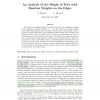Free Online Productivity Tools
i2Speak
i2Symbol
i2OCR
iTex2Img
iWeb2Print
iWeb2Shot
i2Type
iPdf2Split
iPdf2Merge
i2Bopomofo
i2Arabic
i2Style
i2Image
i2PDF
iLatex2Rtf
Sci2ools
CPC
2008
2008
An Analysis of the Height of Tries with Random Weights on the Edges
We analyze the weighted height of random tries built from independent strings of i.i.d. symbols on the finite alphabet {1, . . . , d}. The edges receive random weights whose distribution depends upon the number of strings that visit that edge. Such a model covers the hybrid tries of de la Briandais (1959) and the TST of Bentley and Sedgewick (1997), where the search time for a string can be decomposed as a sum of processing times for each symbol in the string. Our weighted trie model also permits one to study maximal path imbalance. In all cases, the weighted height is shown be asymptotic to c log n in probability, where c is determined by the behavior of the core of the trie (the part where all nodes have a full set of children) and the fringe of the trie (the part of the trie where nodes have only one child and form spaghetti-like trees). It can be found by maximizing a function that is related to the Cram
Related Content
| Added | 10 Dec 2010 |
| Updated | 10 Dec 2010 |
| Type | Journal |
| Year | 2008 |
| Where | CPC |
| Authors | Nicolas Broutin, Luc Devroye |
Comments (0)

